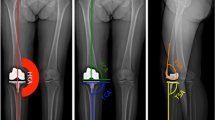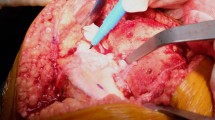Abstract
Purpose
Computer-navigated total knee arthroplasty (TKA) improves the accuracy of component implantation. However, the final implant alignment may not match planned alignment. The hypothesis of this study is that although computer navigation improves alignment, imprecision may not be completely eliminated. The aim of the study was to establish the incidence and sources of imprecision during TKA using computer navigation to measure deviations from planned alignment.
Methods
Computer navigation was used to quantify changes in planned alignment at four steps during 136 TKA’s: application of cutting blocks, addition of definitive pin fixation, bone cuts and after prosthesis application. Mean changes in alignment deviation at each step in each plane were measured and the number of significant outliers (>3° from the planned resection plane) were assessed in each plane.
Results
Overall changes in planned alignment were small and non-cumulative between steps but the incidence of outliers (cuts measured as >3° from planned alignment at each step) increased through the steps, with 21.3 % (n = 29) of final implants outlying in the tibial sagittal plane, which was the least precise plane. The highest number of outliers occurred after bone resection and the addition of pins to cutting blocks was also identified as a source of imprecision.
Conclusion
Despite improved accuracy of bone resection with computer-navigated TKA, the precision of bone cuts may be affected at several steps of the procedure. Cutting block application, bone resection and prosthesis application may all affect accuracy. Bone cuts should be made with meticulous care, whether navigated or not, and navigated cuts should be checked and corrected, particularly in the tibial sagittal plane.
Level of evidence
IV.


Similar content being viewed by others
References
Bargren JH, Blaha JD, Freeman MA (1983) Alignment in total knee arthroplasty. Correlated biomechanical and clinical observations. Clin Orthop Relat Res 173:178–183
Bathis H, Perlick L, Tingart M, Luring C, Zurakowski D, Grifka J (2004) Alignment in total knee arthroplasty. A comparison of computer-assisted surgery with the conventional technique. J Bone Joint Surg Br 86(5):682–687
Bathis H, Perlick L, Tingart M, Perlick C, Luring C, Grifka J (2005) Intraoperative cutting errors in total knee arthroplasty. Arch Orthop Trauma Surg 125(1):16–20
Bauwens K, Matthes G, Wich M, Gebhard F, Hanson B, Ekkernkamp A, Stengel D (2007) Navigated total knee replacement. A meta-analysis. J Bone Joint Surg Am 89(2):261–269
Bedard M, Vince KG, Redfern J, Collen SR (2011) Internal rotation of the tibial component is frequent in stiff total knee arthroplasty. Clin Orthop Relat Res 469:2346–2355
Berend ME, Ritter MA, Meding JB, Faris PM, Keating EM, Redelman R, Faris GW, Davis KE (2004) Tibial component failure mechanisms in total knee arthroplasty. Clin Orthop Relat Res 428:26–34
Biant LC, Yeoh K, Walker PM, Bruce WJ, Walsh WR (2008) The accuracy of bone resections made during computer navigated total knee replacement. Do we resect what the computer plans we resect? Knee 15(3):238–241
Biasca N, Wirth S, Bungartz M (2009) Mechanical accuracy of navigated minimally invasive total knee arthroplasty (MIS TKA). Knee 16(1):22–29
Catani F, Biasca N, Ensini A, Leardini A, Bianchi L, Digennaro V, Giannini S (2008) Alignment deviation between bone resection and final implant positioning in computer-navigated total knee arthroplasty. J Bone Joint Surg Am 90(4):765–771
Catani F, Digennaro V, Ensini A, Leardini A, Giannini S (2011) Navigation-assisted total knee arthroplasty in knees with osteoarthritis due to extra-articular deformity. Knee Surg Sports Traumatol Arthrosc. doi:10.1007/s00167-011-1602-1
Chauhan SK, Clark GW, Lloyd S, Scott RG, Breidahl W, Sikorski JM (2004) Computer-assisted total knee replacement. A controlled cadaver study using a multi-parameter quantitative CT assessment of alignment (the Perth CT Protocol). J Bone Joint Surg Br 86(6):818–823
Cobb J, Henckel J, Gomes P, Harris S, Jakopec M, Rodriguez F, Barrett A, Davies B (2006) Hands-on robotic unicompartmental knee replacement: a prospective, randomised controlled study of the acrobot system. J Bone Joint Surg Br 88(2):188–197
D’Lima DD, Hermida JC, Chen PC, Colwell CW Jr (2001) Polyethylene wear and variations in knee kinematics. Clin Orthop Relat Res 392:124–130
Dorr LD, Deshmane P (2009) Precision surgery. Orthopedics 32(9):659–661
Elloy MA, Manning MP, Johnson R (1992) Accuracy of intramedullary alignment in total knee replacement. J Biomed Eng 14(5):363–370
Green GV, Berend KR, Berend ME, Glisson RR, Vail TP (2002) The effects of varus tibial alignment on proximal tibial surface strain in total knee arthroplasty: the posteromedial hot spot. J Arthroplasty 17(8):1033–1039
Han SB, Nha KW, Yoon JR, Lee DH, Chae IJ (2008) The reliability of navigation-guided gap technique in total knee arthroplasty. Orthopedics 31 (10 Suppl 1)
Hauschild O, Konstantinidis L, Baumann T, Niemeyer P, Suedkamp NP, Helwig P (2010) Correlation of radiographic and navigated measurements of TKA limb alignment: a matter of time? Knee Surg Sports Traumatol Arthrosc 18(10):1317–1322
Jeffery RS, Morris RW, Denham RA (1991) Coronal alignment after total knee replacement. J Bone Joint Surg Br 73(5):709–714
Kamat Y, Aurakzai K, Adhikari A, Matthews D, Kalairajah Y, Field R (2009) Does computer navigation in total knee arthroplasty improve patient outcome at midterm follow-up? Int Orthop 33(6):1567–1570
Kim TK, Chang CB, Kang YG, Chung BJ, Cho HJ, Seong SC (2010) Execution accuracy of bone resection and implant fixation in computer assisted minimally invasive total knee arthroplasty. Knee 17(1):23–28
Kim YH, Kim JS, Choi Y, Kwon OR (2009) Computer-assisted surgical navigation does not improve the alignment and orientation of the components in total knee arthroplasty. J Bone Joint Surg Am 91(1):14–19
Koyonos L, Stulberg SD, Moen TC, Bart G, Granieri M (2009) Sources of error in total knee arthroplasty. Orthopedics 32(5):317–320
Lang JE, Mannava S, Floyd AJ, Goddard MS, Smith BP, Mofidi A, Seyler TM, Jinnah RH (2011) Robotic systems in orthopaedic surgery. J Bone Joint Surg Br 93(10):1296–1299
Laskin R (1984) Alignment of total knee components. Orthopedics 7:62–67
Laskin RS (2003) Instrumentation pitfalls: you just can’t go on autopilot! J Arthroplasty 18(3 Suppl 1):18–22
Lustig S, Fleury C, Goy D, Neyret P, Donell ST (2011) The accuracy of acquisition of an imageless computer-assisted system and its implication for knee arthroplasty. Knee 18(1):15–20
Lutzner J, Gunther KP, Kirschner S (2010) Functional outcome after computer-assisted versus conventional total knee arthroplasty: a randomized controlled study. Knee Surg Sports Traumatol Arthrosc 18(10):1339–1344
Maniar RN, Johorey AC, Pujary CT, Yadava AN (2010) Margin of error in alignment: a study undertaken when converting from conventional to computer-assisted total knee arthroplasty. J Arthroplasty 26(1):82–87
Manzotti A, Cerveri P, De Momi E, Pullen C, Confalonieri N (2010) Relationship between cutting errors and learning curve in computer-assisted total knee replacement. Int Orthop 34(5):655–662
Martin A, von Strempel A (2006) Two-year outcomes of computed tomography-based and computed tomography free navigation for total knee arthroplasties. Clin Orthop Relat Res 449:275–282
Mason JB, Fehring TK, Estok R, Banel D, Fahrbach K (2007) Meta-analysis of alignment outcomes in computer-assisted total knee arthroplasty surgery. J Arthroplasty 22(8):1097–1106
Matsumoto T, Tsumura N, Kurosaka M, Muratsu H, Yoshiya S, Kuroda R (2006) Clinical values in computer-assisted total knee arthroplasty. Orthopedics 29(12):1115–1120
Molfetta L, Caldo D (2008) Computer navigation versus conventional implantation for varus knee total arthroplasty: a case-control study at 5 years follow-up. Knee 15(2):75–79
Nicoll D, Rowley DI (2010) Internal rotational error of the tibial component is a major cause of pain after total knee replacement. J Bone Joint Surg Br 92(9):1238–1244
Otani T, Whiteside LA, White SE (1993) Cutting errors in preparation of femoral components in total knee arthroplasty. J Arthroplasty 8(5):503–510
Pang HN, Yeo SJ, Chong HC, Chin PL, Ong J, Lo NN (2011) Computer-assisted gap balancing technique improves outcome in total knee arthroplasty, compared with conventional measured resection technique. Knee Surg Sports Traumatol Arthrosc 19(9):1496–1503
Pitto RP, Graydon AJ, Bradley L, Malak SF, Walker CG, Anderson IA (2006) Accuracy of a computer-assisted navigation system for total knee replacement. J Bone Joint Surg Br 88(5):601–605
Plaskos C, Hodgson AJ, Inkpen K, McGraw RW (2002) Bone cutting errors in total knee arthroplasty. J Arthroplasty 17(6):698–705
Prakash U, Wigderowitz CA, McGurty DW, Rowley DI (2001) Computerised measurement of tibiofemoral alignment. J Bone Joint Surg Br 83(6):819–824
Ritter MA, Faris PM, Keating EM, Meding JB (1994) Postoperative alignment of total knee replacement. Its effect on survival. Clin Orthop Relat Res 299:153–156
Sikorski JM (2008) Alignment in total knee replacement. J Bone Joint Surg Br 90(9):1121–1127
Sikorski JM, Blythe MC (2005) Learning the vagaries of computer-assisted total knee replacement. J Bone Joint Surg Br 87(7):903–910
Spencer JM, Chauhan SK, Sloan K, Taylor A, Beaver RJ (2007) Computer navigation versus conventional total knee replacement: no difference in functional results at two years. J Bone Joint Surg Br 89(4):477–480
Tew M, Waugh W (1985) Tibiofemoral alignment and the results of knee replacement. J Bone Joint Surg Br 67(4):551–556
Weng YJ, Hsu RW, Hsu WH (2009) Comparison of computer-assisted navigation and conventional instrumentation for bilateral total knee arthroplasty. J Arthroplasty 24(5):668–673
Werner FW, Ayers DC, Maletsky LP, Rullkoetter PJ (2005) The effect of valgus/varus malalignment on load distribution in total knee replacements. J Biomech 38(2):349–355
Windsor RE, Scuderi GR, Moran MC, Insall JN (1989) Mechanisms of failure of the femoral and tibial components in total knee arthroplasty. Clin Orthop Relat Res 248:15–19
Yaffe MA, Koo SS, Stulberg SD (2008) Radiographic and navigation measurements of TKA limb alignment do not correlate. Clin Orthop Relat Res 466(11):2736–2744
Yau WP, Chiu KY (2008) Cutting errors in total knee replacement: assessment by computer assisted surgery. Knee Surg Sports Traumatol Arthrosc 16(7):670–673
Yau WP, Leung A, Chiu KY, Tang WM, Ng TP (2005) Intraobserver errors in obtaining visually selected anatomic landmarks during registration process in nonimage-based navigation-assisted total knee arthroplasty: a cadaveric experiment. J Arthroplasty 20(5):591–601
Conflict of interest
None.
Author information
Authors and Affiliations
Corresponding author
Rights and permissions
About this article
Cite this article
da Assunção, R.E., Hancock, N.J., Bruce, W.J.M. et al. The limits of precision in conventionally instrumented computer-navigated total knee arthroplasty. Knee Surg Sports Traumatol Arthrosc 20, 2528–2534 (2012). https://doi.org/10.1007/s00167-012-1952-3
Received:
Accepted:
Published:
Issue Date:
DOI: https://doi.org/10.1007/s00167-012-1952-3




